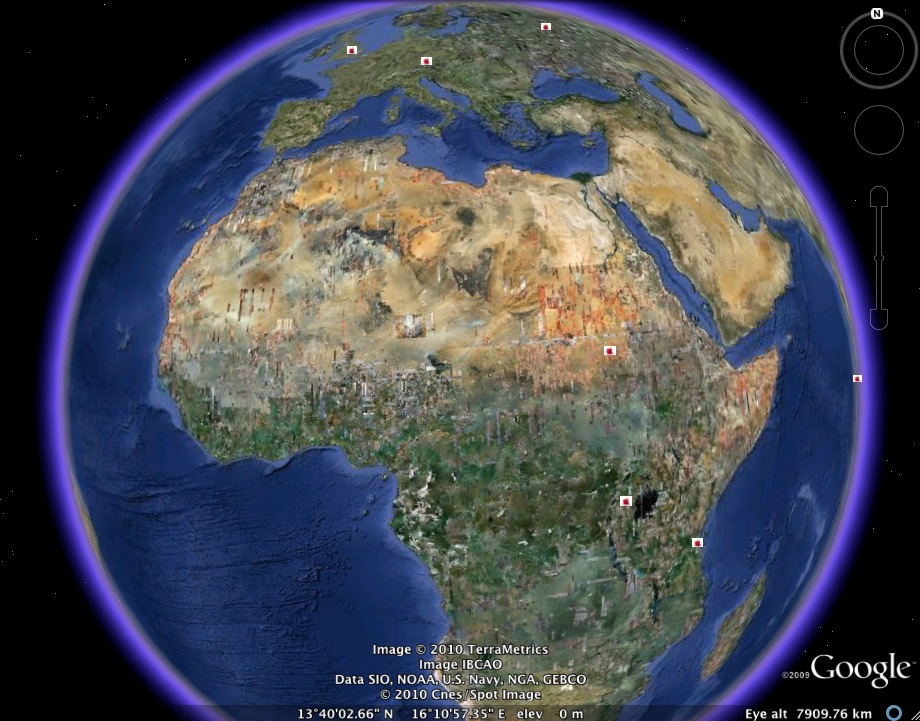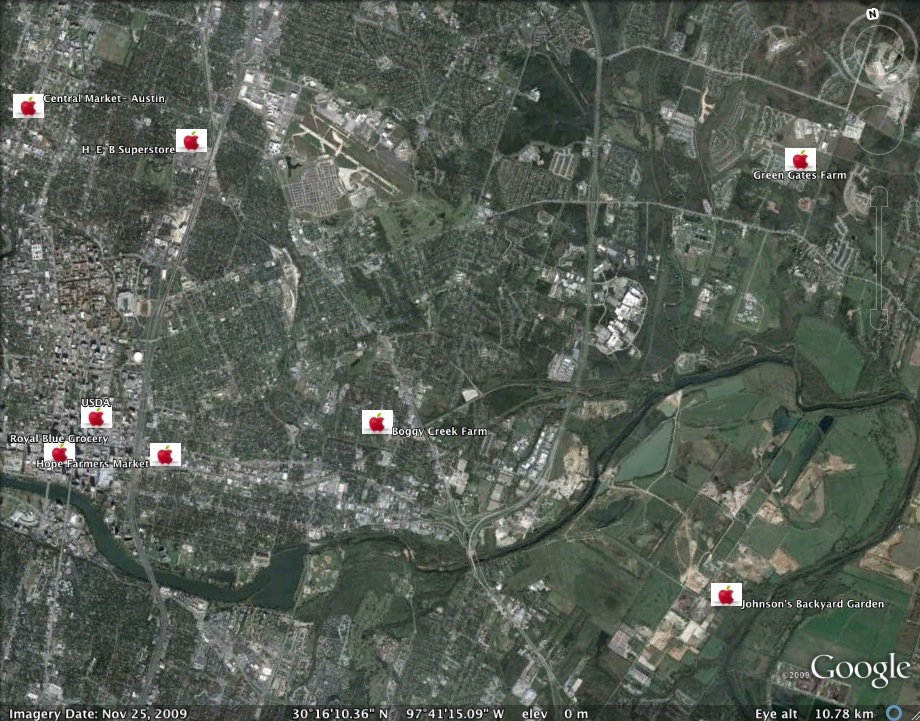
(Image credit: Google Earth map created by Smith's RHE 306)
Caroline and I completed our Food Geographies Collaborative
Writing Workshop last week.
My students decided to keep their class map broad, not
restricting it to Austin, to Texas, or to the United States. As a result, the geographies they trace
are provocative, but also somewhat diffuse. That is, we might have gotten better results by densely
mapping a limited area, but patterns emerge on our worldwide map that would not
otherwise have been visible.
While many students chose to map sites in the Austin area or the United States, the above map shows the efforts of two students who worked on mapping some non-U.S. sites, including major World Food Program sites, fast food locations in developing counties, and key sugar-producing sites. More detail on these sites and others, after the jump.
I had some difficulty getting students to think about food
controversies in terms of what information should go on a map. Many students wanted to map corporate
headquarters of relevant companies such as Kraft, McDonalds, and Monsanto. While I think it’s actually quite helpful
for students to see these companies as physical, located entities, I’m not sure
that their geographical placement on the map tells us as much about food
politics as, say, one students’ mapping of key sugar industry sites, or another
student’s mapping of fast food restaurant locations in developing countries. I’m hoping that we’ll be able to make
more of these connections about the geography of food during our closing
discussion on Tuesday. I wonder
if, in the future, it would be helpful to give the map a more focused theme,
e.g., “How might we map hunger?”
“Or how might we map nutrition?”
Here are some highlights:
- Anna’s mapping of caffeine shows that many major
caffeine-product companies, including Red Bull and Vivarin, are based in
Europe, but have dominant markets in the United States, which she notes has a
global reputation of being addicted to caffeine.
- Daniel’s mapping of World Food Programs features
a massive food cooperative in Uganda that is the World Food Program’s largest
supplier of key commodities. His placemark explains that the
cooperative produces genetically-modified maize, corn, beans, and vegetable
oil, among other crops. He also
placemarked a major food drop-off site in the Sudan which receives large
quantities of genetically-modified foods.
- Griffin’s
mapping of non-U.S. McDonald’s locations shows the influence of American fast
food in both major metropolitan cities and in developing areas. According to Griffin’s placemark,
the McDonald’s location is Pushkin square is the largest-grossing McDonald’s in
the world.
- Two students, Elizabeth and Duyen, teamed up to map farms and Community-Supported Agriculture sites (CSAs) near Austin, TX (as the below map shows), while Kirsten mapped the oldest farmer's market locations in the United States.

(Image credit: Google Earth map of farms and CSAs near Austin, TX, by students in Smith's RHE 306.)
On Tuesday, we’ll finish the exercise by analyzing the map
and having a conversation about what’s missing from our class map. In addition, we’ll overlay Caroline
Wigginton’s class map and discuss the ways the expanded map enacts
collaborative writing. We’ll also
note differences in the two classes’ approach to food politics.
In conclusion, I want to add that the students seemed to
really enjoy this exercise. The
were eager to jump onto computers on find places to plot, latitudes,
longitudes, and images on Tuesday, and on Thursday, as they transferred their
data from the Placemark Data Collection Worksheet to the class spreadsheet
(which they all edited simultaneously from individual computers, using Google
Documents), they were eager to see their results show up on the projection
screen. The exercise was dynamic
and collaborative and provided a refreshing change of focus and pace for the
class.
The students also seem to be interested in the prospect of
composing their final “paper” as a Google Earth narrated tour, an option I’ve
allowed them. I’m looking forward
to receiving a number of these.
Recent comments
2 years 29 weeks ago
2 years 44 weeks ago
2 years 44 weeks ago
2 years 50 weeks ago
3 years 4 weeks ago
3 years 4 weeks ago
3 years 4 weeks ago
3 years 6 weeks ago
3 years 6 weeks ago
3 years 6 weeks ago